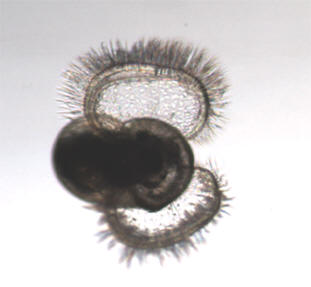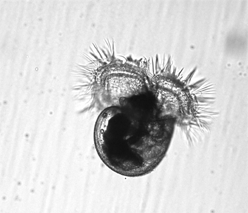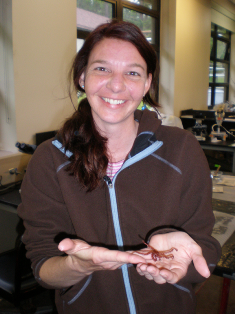


My undergraduate research in the Zacherl lab involved the behavior of Kellet’s Whelk (Kelletia kelletii) larvae. Many marine invertebrate larvae control their vertical position in the water column, potentially influencing dispersal outcomes. Previous laboratory studies with marine gastropod Kelletia kelletii larvae revealed that this species exhibits diel vertical migration (DVM) that is partially controlled by light. I explored light intensity and wavelength as potential cues initiating downward swimming and verified that DVM occurs in the field with plankton tows. I varied full-spectrum light intensity (ranging from 2.5 to 126 mmol·m-2·sec-1) in six replicate 10 cm diameter by 125 cm tall columns each containing 100 one-week old dark-adapted larvae and determined their vertical positions after 2 hrs light exposure. As light intensity decreased, significantly fewer larvae descended (ANOVA, p = <0.0001). At 2.5 mmol·m-2·sec-1 the percent larvae at the top of columns was similar to that in the dark control (p<0.05). The effect of wavelength was tested by comparing blue/green light (450-550 nm) at 14 mmol·m-2·sec- to full spectrum light (380-740 nm) of equivalent intensity. The proportion of descending larvae was significantly different (ANOVA, p=0.0006) indicating that K. kelletii larvae respond differentially to varying wavelengths of light. Surface plankton tows (n=5) were conducted at 1200 h and 2400 h off the coast of Palos Verdes, CA to examine whether laboratory findings were consistent with field vertical distributions of larvae. As predicted by lab studies, there were significantly more larvae at the surface at 2400 hr versus 1200 hr (T-test, p=0.0008). Findings from this study will help develop mathematical models of larval distributions aimed at estimating dispersal outcomes.
Kim Walker loves all things marine!
The light’s on but nobody’s home: Negative phototactic response of Kelletia kelletii larvae to light intensity and wavelength

Kellet's whelk larva from a lab culture.

I
am currently formulating a research question for my master’s thesis.
During my time here at CSUF, I hope to unravel some of the complex
factors that influence dispersal outcomes. Some of the specific topics
that interest me include settlement, larval behavior, and larval
development.



